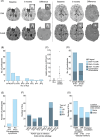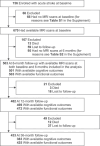Risk factors and clinical significance of post-stroke incident ischemic lesions
- PMID: 39417418
- PMCID: PMC11667539
- DOI: 10.1002/alz.14274
Risk factors and clinical significance of post-stroke incident ischemic lesions
Abstract
Introduction: While incident ischemic lesions (IILs) are not unusual on follow-up magnetic resonance imaging (MRI) following stroke, their risk factors and prognostic significance remain unknown.
Methods: In a prospective multicenter study of 503 acute stroke patients, we assessed IILs on registered MRI images at baseline and 6 months, analyzing risk factors and clinical outcomes across 36 months.
Results: At 6 months, 78 patients (15.5%) had IILs, mostly diffusion-weighted imaging-positive (72%) and clinically covert (91%). Older age and small vessel disease (SVD) lesions were baseline risk factors for IILs. IILs were associated with worse cognitive (beta for global cognition: -0.31, 95% confidence interval [CI]: -0.48 to -0.14) and functional outcomes (beta for modified Rankin scale [mRS]: 0.36, 95% CI: 0.14 to 0.58), and higher recurrent stroke risk (hazard ratio: 3.81, 95% CI: 1.35 to 10.69). IILs partially explained the relationship between SVD and poor cognition.
Discussion: IILs are common and are associated with worse cognitive and functional outcomes and stroke recurrence risk. Assessing IILs following stroke might aid prognostication.
Highlights: Incident ischemic lesions (IILs) were assessed with registered baseline and 6-month magnetic resonance imaging (MRI) scans in a stroke cohort. IILs 6 months after stroke are present in one-sixth of patients and are mostly clinically silent. Small vessel disease burden is the main baseline risk factor for IILs. IILs are associated with cognitive and functional impairment and stroke recurrence. Assessing IILs by follow-up MRI aids long-term prognostication for stroke patients.
Keywords: cerebral small vessel disease; cognitive impairment; functional outcome; incident ischemic lesions; recurrent stroke; stroke.
© 2024 The Author(s). Alzheimer's & Dementia published by Wiley Periodicals LLC on behalf of Alzheimer's Association.
Conflict of interest statement
Dr. Duering reports consulting for Roche, serving on the scientific advisory board for Biogen, and receiving speaker honoraria from Sanofi Genzyme, all outside of the submitted work. Dr. Nolte reports speaker honoraria and/or lecture fees from Abbott, Alexion, AstraZeneca, BMS, Daiichi Sankyo, Novartis, Pfizer, and Takeda, all outside the submitted work. Dr. Endres reported receiving grants from Bayer and fees paid to the Charité – Universitätsmedizin Berlin from Amgen, AstraZeneca, Bayer Healthcare, Boehringer Ingelheim, BMS, Daiichi Sankyo, Sanofi, and Pfizer, all outside the submitted work. Other (Leadership or fiduciary role in other board, society, committee or advocacy group, paid or unpaid): European Academy of Neurology (Board of directors, unpaid), German Society of Neurology (Member, unpaid), International Society of Cerebral Blood Flow Metabolism (Member, unpaid), American Heart Association/American Stroke Association (Member, unpaid), World Stroke Organization (Member, unpaid), European Stroke Organisation (Fellow, unpaid), German Center of Neurodegenerative Diseases (personal contract, paid). All other authors declare no conflicts of interest. Author disclosures are available in the supporting information.
Figures



References
Publication types
MeSH terms
Grants and funding
- Vascular Demenztia Research Foundation
- German Research Foundation (DFG)
- BMBF-01KC2002A/Federal Ministry of Education and Research
- DZNE-BN012/German Center for Neurodegenerative Diseases
- DZNE-MC002/German Center for Neurodegenerative Diseases
- DZHK-81×1100217/122677/Deutsches Zentrum für Herz-Kreislauf-Forschung
- DZHK-81Z0100209/Deutsches Zentrum für Herz-Kreislauf-Forschung
- SA199/10060/2014/Corona Foundation
- AVD117181/Fondation Leducq
- GZ: GE 3461/2-1/Emmy Noether grant
- ID 512461526/Emmy Noether grant
- EXC 2145 SyNergy/Munich Cluster for Systems Neurology
- EXC-2049 - 390688087/Munich Cluster for Systems Neurology
- EXC 2145 SyNergy ID 390857198/Munich Cluster for Systems Neurology
- German Research Foundation
- Ref. 10.22.2.024MN/Fritz-Thyssen Foundation
- ID P1230035/Gemeinnützige Hertie-Stiftung (Hertie Network of Excellence in Clinical Neuroscience)
- TRR295-424778381/Collaborative Research Center ReTune
- project2EN343/16-1/Clinical Research Group KFO 5023 BeCAUSE-Y
LinkOut - more resources
Full Text Sources
Medical

